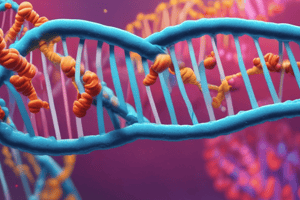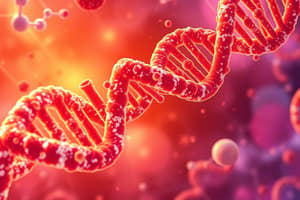Podcast
Questions and Answers
What is the role of helicase in DNA replication?
What is the role of helicase in DNA replication?
- Adding complementary nucleotides to the new DNA strands
- Ensuring replication is completed at each replication fork
- Assembling a new DNA strand using the template as a guide
- Creating a replication fork and unwinding the DNA (correct)
Which enzyme is the main player in DNA replication by adding complementary nucleotides to create new DNA strands?
Which enzyme is the main player in DNA replication by adding complementary nucleotides to create new DNA strands?
- Primase
- Helicase
- DNA ligase
- DNA polymerase (correct)
Which proteins ensure that replication has been completed at each replication fork in DNA replication?
Which proteins ensure that replication has been completed at each replication fork in DNA replication?
- Terminators (correct)
- DNA ligase
- DNA polymerase
- Helicase
What is the process where DNA polymerase adds nucleotides to the growing strand using a single-stranded template as a guide?
What is the process where DNA polymerase adds nucleotides to the growing strand using a single-stranded template as a guide?
In DNA replication, which enzyme is responsible for joining Okazaki fragments on the lagging strand?
In DNA replication, which enzyme is responsible for joining Okazaki fragments on the lagging strand?
What is the main function of DNA Polymerase in DNA replication?
What is the main function of DNA Polymerase in DNA replication?
Which enzyme is responsible for producing short RNA primers to help initiate DNA synthesis?
Which enzyme is responsible for producing short RNA primers to help initiate DNA synthesis?
What is the role of Ligase in DNA replication?
What is the role of Ligase in DNA replication?
In which direction does the leading strand grow during DNA replication?
In which direction does the leading strand grow during DNA replication?
Where does the formation of Okazaki fragments occur during DNA replication?
Where does the formation of Okazaki fragments occur during DNA replication?
Flashcards
Replication Fork
Replication Fork
Y-shaped structure where DNA separates for replication.
Helicase
Helicase
Unwinds the DNA double helix at the replication fork.
DNA Polymerase
DNA Polymerase
Synthesizes new DNA strands using the template.
Ligase
Ligase
Signup and view all the flashcards
Primase
Primase
Signup and view all the flashcards
Leading Strand
Leading Strand
Signup and view all the flashcards
Lagging Strand
Lagging Strand
Signup and view all the flashcards
Okazaki Fragments
Okazaki Fragments
Signup and view all the flashcards
Terminators
Terminators
Signup and view all the flashcards
Semiconservative replication
Semiconservative replication
Signup and view all the flashcards
Study Notes
Unraveling DNA Replication: A Step-by-Step Guide
Imagine for a moment that you're a cellular-scale architect. You've constructed a remarkable building that's filled with residents—the cells of your body. Now imagine the building needs to be expanded without destroying the current structure or evicting the tenants. That's a lot like DNA replication, a process that ensures the accurate transmission of genetic information from one generation of cells to the next.
The Steps of DNA Replication
- Initiation: The cell prepares for replication by creating a replication fork, a Y-shaped structure where the double helix of DNA separates into two single strands. Enzymes like helicase unwind the DNA at the replication fork.
- Synthesis: DNA polymerase, the main player in replication, moves along the single strands and adds complementary nucleotides to create new DNA strands. The nucleotides are chosen based on their complementary base pairing: adenine (A) pairs with thymine (T), and cytosine (C) pairs with guanine (G).
- Elongation: The DNA polymerase enzyme assembles a new DNA strand using the single-stranded template as a guide, adding nucleotides to the growing strand through a process called semiconservative replication.
- Termination: The cell ensures that replication has been completed at each replication fork by using proteins called terminators.
The Enzymes Involved in DNA Replication
- Helicase: An enzyme that unwinds the DNA double helix, separating the two strands at the replication fork.
- DNA Polymerase: The enzyme responsible for synthesizing new DNA strands using the single-stranded template.
- Ligase: A sealer of the gaps left in the newly synthesized DNA strands during replication.
- Primase: Produces short RNA primers that help initiate DNA synthesis at the replication fork.
Leading and Lagging Strands
The growing DNA strands at the replication fork are separated into leading and lagging strands. The leading strand grows continuously in the direction of replication, while the lagging strand grows in short segments called Okazaki fragments, which are later joined together.
The Replication Fork
The replication fork is the point where the double helix of DNA separates into single strands, allowing the synthesis of new DNA strands. This site contains several enzymes and proteins that facilitate the process, including DNA polymerase, primase, and helicase.
In summary, DNA replication is a complex and vital process that ensures the accurate transmission of genetic information from one generation of cells to the next. It relies on a series of well-coordinated enzymes and proteins that work together at the replication fork to untangle, duplicate, and seal the new DNA strands.
Studying That Suits You
Use AI to generate personalized quizzes and flashcards to suit your learning preferences.




